King's Arms Hotel, Dorchester, Sunday morning, 20 August 2000
Friday we visited Exeter cathedral, a particularly fetching and coherent example of the middle or Decorated style of English Gothic. For a pound I got permission to photograph the interior, so here follows a fairly extensive photo album. One feature not shown here, with which Stas was very taken, is the set of colorful needlepoint seat cushions, the "Exeter Rondels," completed in 1989. They run the whole length of the nave on one side and chronicle the cathedral's long past in fourteen million stitches. Another treasure not shown below is the country's biggest carved-wood canopy for a cathedra or bishop's throne, elaborately and quite beautifully carved in the fourteenth or fifteenth century for the sum of a mere twelve pounds (but then, how much did a medieval woodcarver have to spend for a pint of beer to wash the sawdust from his throat?).
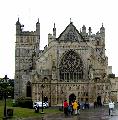

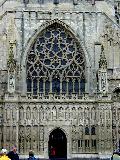 On the left you see the west front (where one enters), viewed not quite square on. Norman towers rise over the north and south transepts, not terribly tall, and there are no west towers or central tower. The cathedral is not all that lofty in general; it is, if anything, squat in comparison with many others. Photos at right show the west window, both from the outside and from the inside. The curving stone traceries that divide up such window openings, especially their arched upper portions, are chiefly what give the Decorated style its name. The later Perpendicular style achieved greater economy of stone, so there was more glass, but it was at the expense of this exuberance of line.
On the left you see the west front (where one enters), viewed not quite square on. Norman towers rise over the north and south transepts, not terribly tall, and there are no west towers or central tower. The cathedral is not all that lofty in general; it is, if anything, squat in comparison with many others. Photos at right show the west window, both from the outside and from the inside. The curving stone traceries that divide up such window openings, especially their arched upper portions, are chiefly what give the Decorated style its name. The later Perpendicular style achieved greater economy of stone, so there was more glass, but it was at the expense of this exuberance of line.
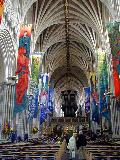
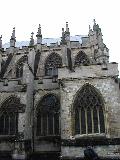
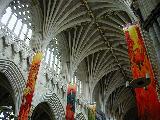 The ribbed stone ceiling vault with painted bosses is particularly choice--besides being "the longest unbroken Gothic vault in the world" according to the ten-penny brochure--and in this respect the relatively modest height of the cathedral has its advantages, since one gets a closer view. In the Decorated period some of these vaults got to be rather over-complicated, with a network of short struts and a superabundance of bosses at the resulting intersections; but this one is free of such fussiness. At left we are looking straight down the principal space, the nave, of the cathedral. The more oblique view at right shows the characteristic three rows of arches that line the nave. At the bottom the main arcade opens to the aisles that run alongside the nave on either side. Above that runs the blind arcade of the triforium, masking where the roofs of the aisles slope in. Above that again come the traceried and clear-glazed windows of the clerestory, letting in light. In this case the clerestory windows have different tracery patterns one from the next. Two of these patterns can be matched with the exterior view of the same portion of the building. Also visible in the exterior view, alternating with the clerestory windows, are flying buttresses, "flying" in the sense that there is open space underneath them. These buttresses bridge the space above the aisle roofs, and take some of the load of the nave vault and roof, while shading the clerestory as little as possible.
The ribbed stone ceiling vault with painted bosses is particularly choice--besides being "the longest unbroken Gothic vault in the world" according to the ten-penny brochure--and in this respect the relatively modest height of the cathedral has its advantages, since one gets a closer view. In the Decorated period some of these vaults got to be rather over-complicated, with a network of short struts and a superabundance of bosses at the resulting intersections; but this one is free of such fussiness. At left we are looking straight down the principal space, the nave, of the cathedral. The more oblique view at right shows the characteristic three rows of arches that line the nave. At the bottom the main arcade opens to the aisles that run alongside the nave on either side. Above that runs the blind arcade of the triforium, masking where the roofs of the aisles slope in. Above that again come the traceried and clear-glazed windows of the clerestory, letting in light. In this case the clerestory windows have different tracery patterns one from the next. Two of these patterns can be matched with the exterior view of the same portion of the building. Also visible in the exterior view, alternating with the clerestory windows, are flying buttresses, "flying" in the sense that there is open space underneath them. These buttresses bridge the space above the aisle roofs, and take some of the load of the nave vault and roof, while shading the clerestory as little as possible.

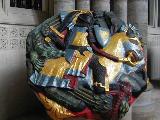 At left is a view straight up into the nave vault. At right is a full-sized papier-mâché replica of one of the central bosses of that vault (the one directly over the transept crossing, not shown in the photo at left). About a yard across, it depicts Christian virtue as a knight, vanquishing three dragons representing the world, the flesh, and the devil. (Too bad actual flesh-and-blood knights had only their fellow human beings to hack up with their swords, their pretensions to Christian virtue thus falling foul of the sixth commandment.)
At left is a view straight up into the nave vault. At right is a full-sized papier-mâché replica of one of the central bosses of that vault (the one directly over the transept crossing, not shown in the photo at left). About a yard across, it depicts Christian virtue as a knight, vanquishing three dragons representing the world, the flesh, and the devil. (Too bad actual flesh-and-blood knights had only their fellow human beings to hack up with their swords, their pretensions to Christian virtue thus falling foul of the sixth commandment.)
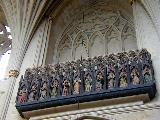 A dozen carved and painted angels play in this high minstrels' gallery.
A dozen carved and painted angels play in this high minstrels' gallery.
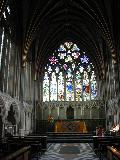 Here are our children in the Lady Chapel, the easternmost part of the building.
Here are our children in the Lady Chapel, the easternmost part of the building.
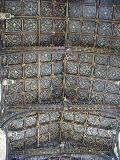 Finally, here is the original timber ceiling of the fifteenth-century rectangular chapter house.
Finally, here is the original timber ceiling of the fifteenth-century rectangular chapter house.
After lunch in Lyme Regis we got to Dorchester yesterday afternoon to find our reservation gone bad, so we scrambled around for accommodations. We wound up at the King's Arms, which is a bit over budget for us but centrally located and rich in Hardy associations. We picked up on arrival the Thomas Hardy Society's pamphlet Walk Round Dorchester (Casterbridge) with Hardy, and today we plan to do one or two of the walks outlined therein.
previous entry
next entry
main/ToC page


 On the left you see the west front (where one enters), viewed not quite square on. Norman towers rise over the north and south transepts, not terribly tall, and there are no west towers or central tower. The cathedral is not all that lofty in general; it is, if anything, squat in comparison with many others. Photos at right show the west window, both from the outside and from the inside. The curving stone traceries that divide up such window openings, especially their arched upper portions, are chiefly what give the Decorated style its name. The later Perpendicular style achieved greater economy of stone, so there was more glass, but it was at the expense of this exuberance of line.
On the left you see the west front (where one enters), viewed not quite square on. Norman towers rise over the north and south transepts, not terribly tall, and there are no west towers or central tower. The cathedral is not all that lofty in general; it is, if anything, squat in comparison with many others. Photos at right show the west window, both from the outside and from the inside. The curving stone traceries that divide up such window openings, especially their arched upper portions, are chiefly what give the Decorated style its name. The later Perpendicular style achieved greater economy of stone, so there was more glass, but it was at the expense of this exuberance of line. 






